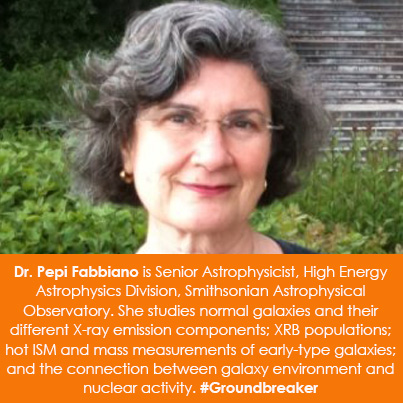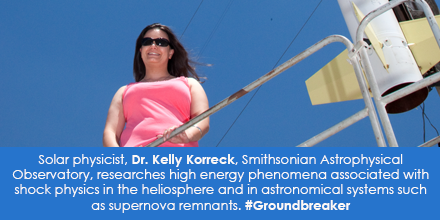Results for "High Energy Astrophysical Observatory"

Women in Science Wednesday: Dr. Pepi Fabbiano
- Date: February 4, 2015
- Creator: Effie Kapsalis
- Description: Dr. Pepi Fabbiano is Senior Astrophysicist, High Energy Astrophysics Division, Smithsonian Astrophysical Observatory. She studies normal galaxies and their different X-ray emission components; XRB populations; hot ISM and mass measurements of early-type galaxies; and the connection between galaxy environment and nuclear activity. #Groundbreaker
- Blog Post
Star Birth, Star Death
- Date: January 31, 2011
- Creator: Catherine Shteynberg
- Description: Today, three new images of starbursts and colliding galaxies from the Smithsonian Astrophysical Observatory’s Chandra X-ray team were uploaded to the Smithsonian's Flickr Commons stream.
- Blog Post
New Commons Photos: The Destiny of a Galaxy
- Date: August 11, 2010
- Creator: Catherine Shteynberg
- Description: In the past week, a series of six more images from the Smithsonian Astrophysical Observatory’s Chandra X-ray team were uploaded to the Flickr Commons. Incidentally, they are all images of supernovas and black holes. Visualizing black holes is a challenge (at least for me) as the term conjures up images in my own head of silent, black infinity. But luckily for us (and as you
- Blog Post
New Image of Supernova
- Date: April 8, 2009
- Creator: Effie Kapsalis
- Description: [caption id="" align="aligncenter" width="385" caption="A Young Pulsar Shows its Hand, Smithsonian Astrophysical Observatory"][/caption] On Friday, April 3, the Chandra X-ray Observatory released a new image (with 10 times more data) of supernova B1509 which is now available on the Smithsonian Flickr Commons photostream. Chandra orbits the earth every 2.5 days capturing images
- Blog Post
In Memoriam: Riccardo Giacconi (1931–2018)
- Date: December 17, 2018
- Creator: Tammy L. Peters
- Description: The Smithsonian Institution Archives remembers Riccardo Giacconi (1931–2018)
- Blog Post
Seeing the Invisible
- Date: May 11, 2009
- Description: Throughout May and June, we are inviting people throughout the Smithsonian to talk about photography and astronomy. This is the first installment from Megan Watzke, Press Officer at the Smithsonian Astrophysical Observatory. Most people think of a telescope as something in a backyard or the dome at the local planetarium. And it’s true that many telescopes are designed to

Early 20th-Century Women Computers at the Smithsonian
- Date: August 12, 2021
- Description: Learn about Florence A. Graves, Gladys Thurlby Bond, and Nancy Prichard, three 20th century women computers who advanced solar research.

Wonderful Women Wednesday: Dr. Kelly Korreck
- Date: March 22, 2017
- Creator: Effie Kapsalis
- Creator: Effie Kapsalis

Right Places at the Right Time
- Date: October 21, 2013
- Creator: Tammy L. Peters
- Description: Recollections of the October 4, 1957, Sputnik I launch and the Smithsonian Astrophysical Observatory's Satellite Tracking Program.

Women in Science Wikipedia Edit-a-thon III
- Date: March 17, 2015
- Creator: Effie Kapsalis
- Description: Cue the music! We invite you to our third "She Blinded Me with Science" Women in Science Wikipdia Edit-a-thon III. An invitation to the Archive's 3rd Wikipedia edit-a-thon on Women in Science, March 27, 2015.

Science Conversations in the Shenandoah
- Date: September 6, 2018
- Creator: Mitch Toda
- Description: In February 1975, twenty Smithsonian scientists gathered at the National Zoo's Conservation Research Center in Front Royal, Virginia to talk about their research and the future of science at the Smithsonian.

Samuel Pierpont Langley and the Personal Equation Problem
- Date: April 12, 2018
- Description: The term “personal equation” came into use in the 19th century as scientists found that observers have inherent biases: some anticipate events, and some report events after they have occurred. Recognition of the problem led to a spate of personal equation instruments: some measured biases of this sort, and some reduced the effect of personal errors. Most of these
